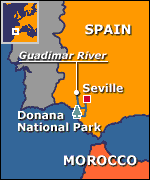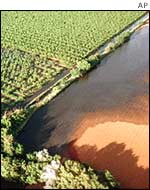Damage to fragile environments: Doñana National Park pollution
Cause: toxic waste spillage from the Boliden lead-zinc mine
On April 25, 1998 one of waste lagoon dams of the Los Frailes lead-zinc mine belonging to the Swedish - Canadian enterprise Boliden in Aznalcóllar broke. Five million cubic metres of toxic sludge and acid waters flowed over 60 kilometers of the Guadiamar River, the salt marshes and Entremuros, eliminating aquatic life and depositing heavy metals throughout the area. The avalanche of water and sludge was stopped just before arriving to the Doñana National Park thanks to the rapid construction of an emergency dam.
The Doñana national park is Europe's largest wildlife reserve. It covers over 75,000 hectares (185,000 acres) along Spain's southwestern coast, providing shelter for millions of migratory birds and housing threatened species such as lynx and imperial eagle.
 |
| Location of Doñana national park |
Underlying Causes
- Dam wall retaining toxic waste was badly designed
- Poor safety inspections by the government
- Mine waste lagoons constitute one of the greatest environmental threats, not only in Spain but also worldwide
- Until this event, fines for pollution in Spain have been so low, they have been regarded as an acceptable business cost. It has been cheaper to pay the fine than take adequate safeguards.
Millions of gallons of toxic water leaked from the dam
Reasons for the dam failure The reason for the foundation failure, and the failure of the mine management to foresee the problem is still a matter of discussion, although a number of theories have been proposed. The mine operators claim that there was no way to foresee the incident and have subsequently blamed construction contractors for misinterpreting the geotechnical properties of the site. A report prepared for the mining company described the weak point of the dam two years in advance of the failure. Geotechnical experts suggest that the foundation failure was caused by chemical attack of the impounded acidic pyritic slurries on the marl forming the dam foundation material. Other experts suggest that the dam was built on expansive clays which deformed with wetting and drying. They claim that the expansion and contraction of the clays should have been accounted for in the design of the dam. In addition, reports indicate that the subsoil was unsuitable to support the mass of tailings that were piled up in the dam. Acidic seepage, combined with continued blasting in the nearby open pit mine would have contributed to the dam failure. Other experts suggest that the dam was designed with insufficient beach width and that the dam was being filled at a rate higher that it was designed for. |
Specific Causes and Effects
| Causes | Effects | |
| Mine waste lagoon dam wall collapsed,
releasing zinc, lead and cadmium toxic waste into the River Guadiamar, a fragile
wetland habitat
|
• High river acidity levels
• River bank vegetation killed • Death of thousands of fish and other wild life. The contamination reached the food chain and stork malformations and tumours have been detected. • 10,000 hectares of farmland along the banks of the river poisoned. Thousands of farmers have seen their crops ruined. The farming commune of Aznalcazar alone lost 3,500 hectares (8,645 acres) of fields growing rice, cotton and citrus fruit. Some 250 farmers and 500 day-jobbers were estimated to have "lost everything". • Loss of tourist income • Wells and groundwater contaminated • It could take 40 years for the farmlands and wetlands to recover. The toxic metals do not naturally breakdown.• The authorities announced a $270m clean-up plan funded by the Spanish Government and the European Union after the spill. • At the beginning of 2000, Boliden abandoned its mining activities in Spain without undertaking the appropriate mine closure and firing its whole staff, 425 workers • The company filed for bankruptcy in October 2000 to avoid a $45 million fine imposed by the Spanish government.
|

 The sludge did not enter Doñana but coated nearby farmland
The sludge did not enter Doñana but coated nearby farmland